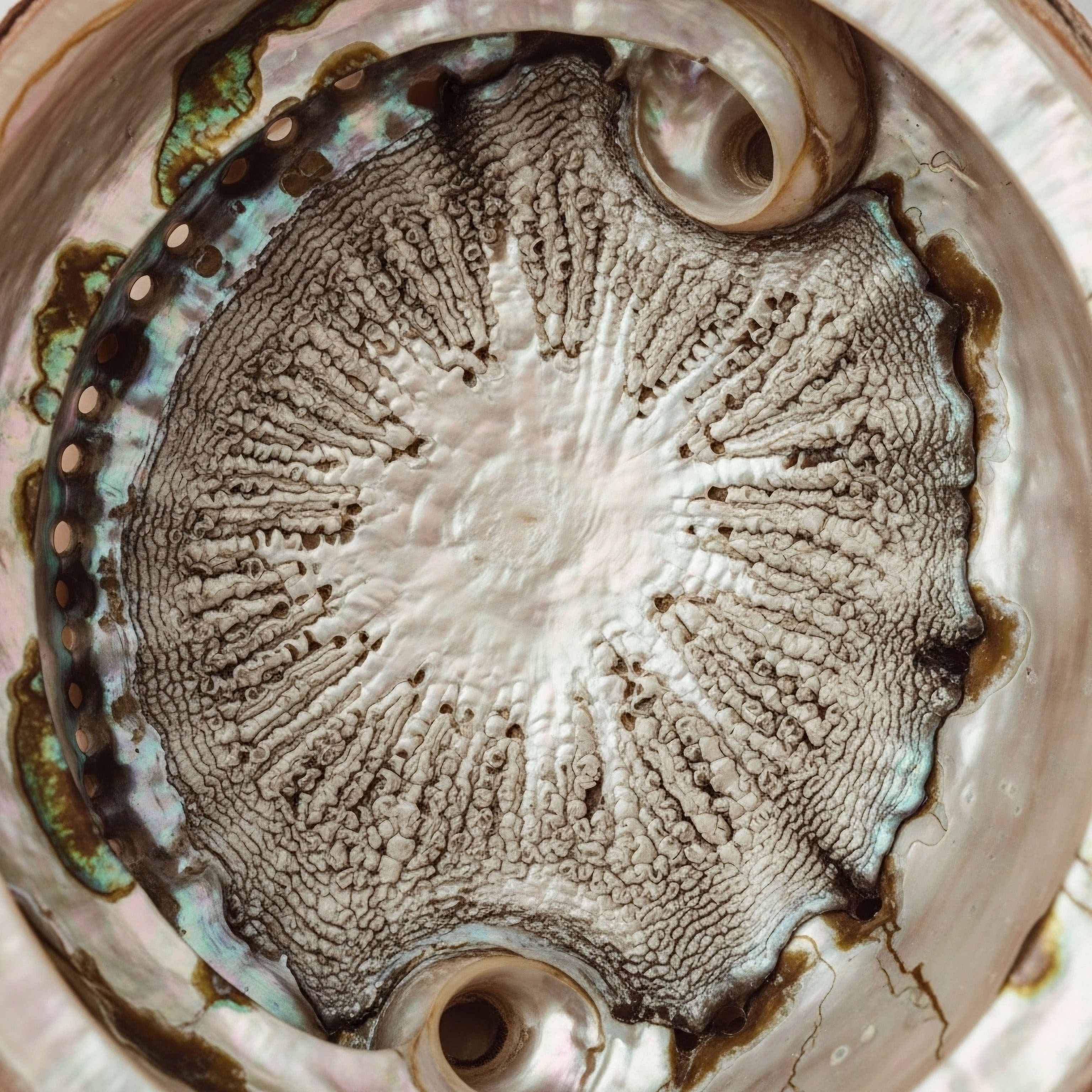

Fundamentals
Have you ever found yourself grappling with a persistent sense of fatigue, a subtle but undeniable shift in your energy levels, or perhaps a feeling that your body’s internal rhythm has simply gone awry? Many individuals experience these sensations, often attributing them to the demands of modern life or the natural progression of years.
Yet, these feelings can often be whispers from your endocrine system, signals that its intricate communication network might be operating outside its optimal balance. Understanding these internal messages is the first step toward reclaiming your vitality and restoring a sense of harmonious function within your biological systems.
Within this complex internal landscape, testosterone stands as a pivotal signaling molecule, recognized for its widespread influence beyond what many might initially consider. While commonly associated with male physiology, it plays a vital role in both men and women, impacting energy, mood, body composition, and overall metabolic health.
When the body’s production of this hormone falters, or when external sources are introduced to recalibrate its levels, a cascade of systemic adjustments begins. One such adjustment involves the body’s blood composition, specifically the proportion of red blood cells.
This brings us to hematocrit, a fundamental measure in blood analysis. Simply put, hematocrit represents the percentage of your total blood volume that is occupied by red blood cells. These cells are the primary carriers of oxygen throughout your body, delivering this vital element to every tissue and organ.
A healthy hematocrit level ensures efficient oxygen transport, supporting robust cellular function and overall physiological performance. Deviations from this optimal range, whether too low or too high, can signal underlying imbalances that warrant careful consideration.
The body possesses an extraordinary capacity for maintaining internal stability, a process known as homeostasis. This dynamic equilibrium ensures that crucial physiological parameters, such as blood pressure, temperature, and indeed, blood cell counts, remain within tightly regulated ranges. When external testosterone is administered, it introduces a new variable into this finely tuned system.
The body’s homeostatic mechanisms respond, sometimes by adjusting red blood cell production, leading to changes in hematocrit. These changes are not random occurrences; they are direct responses from a system striving to adapt to new internal signals.
Understanding your body’s response to hormonal adjustments, such as changes in hematocrit, empowers you to partner effectively in your wellness journey.
The way testosterone is introduced into the body significantly influences how these internal communication systems react. Different administration methods create distinct patterns of hormone delivery, leading to varying peak and trough levels of testosterone in the bloodstream. These fluctuating or steady concentrations, in turn, can have differential effects on the body’s erythropoietic machinery ∞ the sophisticated process responsible for generating red blood cells.
Recognizing these distinctions is paramount for anyone considering or undergoing hormonal optimization protocols, as it allows for a more informed and personalized approach to care.

What Is Hematocrit and Why Does It Matter?
Hematocrit is a straightforward yet powerful indicator of your blood’s oxygen-carrying capacity. It is typically measured as part of a complete blood count (CBC). A healthy range generally falls between 40% and 50% for men and 35% and 45% for women, though these values can vary slightly based on individual factors and laboratory references.
When hematocrit levels rise above the normal range, a condition known as erythrocytosis or polycythemia can develop. This increase in red blood cell volume can thicken the blood, making it more viscous. Increased blood viscosity can place additional strain on the cardiovascular system, potentially impacting blood flow and increasing the risk of certain health considerations.
Conversely, a hematocrit level that is too low indicates anemia, a condition where the blood lacks sufficient healthy red blood cells to carry adequate oxygen to the body’s tissues. While testosterone therapy is primarily used to address symptoms of low testosterone, it can also be beneficial for individuals with hypogonadism who also experience anemia, as it can stimulate red blood cell production.

The Body’s Red Blood Cell Production System
The production of red blood cells, or erythropoiesis, is a tightly regulated biological process primarily occurring in the bone marrow. This intricate system is overseen by a hormone called erythropoietin (EPO), which is predominantly produced by the kidneys. When oxygen levels in the blood decrease, the kidneys release more EPO, signaling the bone marrow to accelerate red blood cell production.
This feedback loop ensures that the body maintains an adequate supply of oxygen-carrying cells. Testosterone, as an androgen, interacts with this system, influencing the rate at which red blood cells are generated.
The influence of testosterone on erythropoiesis is a well-documented physiological effect. Exogenous testosterone, meaning testosterone administered from an external source, tends to stimulate this process. This stimulation can lead to an increase in both hemoglobin and hematocrit levels. While a modest increase can be beneficial, particularly for individuals with low red blood cell counts, an excessive rise can lead to concerns related to blood viscosity.


Intermediate
The journey toward hormonal balance often involves a careful consideration of how therapeutic agents are introduced into the body. Different methods of testosterone administration are akin to various delivery systems, each with its own unique pharmacokinetic profile ∞ that is, how the body absorbs, distributes, metabolizes, and eliminates the hormone. These distinct profiles directly influence the patterns of testosterone levels in the bloodstream, which in turn, affect the degree of erythropoietic stimulation and, consequently, hematocrit levels.

Understanding Testosterone Delivery Systems
Testosterone replacement therapy (TRT) offers several administration routes, each designed to provide the body with the necessary hormonal support. The choice of method often depends on individual preferences, lifestyle, and clinical considerations, including the potential impact on hematocrit.
- Intramuscular Injections ∞ This method involves injecting testosterone esters, such as testosterone cypionate or enanthate, deep into a muscle, typically on a weekly or bi-weekly schedule. These oil-based formulations are absorbed slowly from the injection site, leading to a characteristic peak-and-trough pattern in serum testosterone levels. Levels rise significantly after injection, then gradually decline until the next dose.
- Subcutaneous Injections ∞ A more recent and increasingly popular approach involves injecting testosterone cypionate or enanthate into the subcutaneous fat layer. This method offers comparable pharmacokinetics to intramuscular injections but often with less pain and easier self-administration. It can also lead to more stable testosterone levels with fewer dramatic fluctuations.
- Transdermal Gels and Creams ∞ These topical preparations are applied daily to the skin, allowing for continuous absorption of testosterone into the bloodstream. This method typically results in more stable, physiological testosterone levels throughout the day, avoiding the sharp peaks seen with injections.
- Transdermal Patches ∞ Similar to gels, patches deliver testosterone through the skin, providing a sustained release over a 24-hour period. This method also aims for more consistent hormone levels.
- Subcutaneous Pellets ∞ Small, solid pellets containing crystalline testosterone are implanted under the skin, usually in the hip or buttock area. These pellets provide a slow, continuous release of testosterone over several months, offering a highly stable and sustained hormone delivery.
- Oral Formulations ∞ While some oral testosterone preparations exist, they are less commonly used due to concerns about liver metabolism and variable absorption. Oral testosterone undecanoate is an exception, designed to bypass significant first-pass liver metabolism.

Pharmacokinetic Profiles and Hematocrit Influence
The way testosterone is delivered directly impacts its concentration patterns in the blood, which in turn influences erythropoiesis. Methods that create higher peak testosterone levels or more significant fluctuations are generally associated with a greater propensity for hematocrit elevation.
Intramuscular injections, with their characteristic peaks and troughs, tend to produce the most pronounced increases in hematocrit. This is likely due to the supraphysiological peaks of testosterone achieved shortly after injection, which can provide a stronger stimulus to red blood cell production. A network meta-analysis revealed that intramuscular testosterone enanthate/cypionate was associated with a significantly higher increase in mean hematocrit compared to transdermal patches.
The choice of testosterone administration method significantly shapes the body’s hematocrit response, reflecting distinct pharmacokinetic patterns.
Transdermal gels and patches, which deliver testosterone more continuously and result in steadier blood levels, generally lead to smaller increases in hematocrit. This more physiological delivery pattern appears to mitigate the erythropoietic stimulus. Subcutaneous injections, while still injectable, may offer a middle ground, potentially providing more stable levels than intramuscular injections and thus a reduced, though still present, impact on hematocrit.
Testosterone pellets, offering sustained release, have also been shown to cause a statistically significant, but often clinically less relevant, increase in hematocrit. One study reported an average increase of 2.2% with pellet implantation, which was deemed unlikely to translate into clinical concern for the studied cohort.

Clinical Protocols and Ancillary Medications
Managing potential hematocrit elevation is an integral part of responsible testosterone optimization protocols. Regular monitoring of hematocrit levels is crucial, typically at baseline, then at 3, 6, and 12 months after initiating therapy, and annually thereafter. If hematocrit levels rise above a certain threshold, typically 54%, interventions are considered.
For men undergoing testosterone replacement therapy, standard protocols often involve weekly intramuscular injections of Testosterone Cypionate (200mg/ml). To mitigate potential side effects, including those related to hematocrit, and to support overall endocrine health, additional medications may be included ∞
- Gonadorelin ∞ Administered via subcutaneous injections, often twice weekly, Gonadorelin aims to maintain natural testosterone production and fertility by stimulating the pituitary gland to release luteinizing hormone (LH) and follicle-stimulating hormone (FSH). While its direct impact on hematocrit is not primary, by supporting endogenous production, it contributes to a more balanced hormonal environment.
- Anastrozole ∞ This oral tablet, typically taken twice weekly, functions as an aromatase inhibitor. It blocks the conversion of testosterone into estrogen, which can be a concern with exogenous testosterone administration. Managing estrogen levels can indirectly influence hematocrit, as estrogen also plays a role in hematopoiesis. Maintaining optimal estradiol levels is considered important for overall health and can help minimize side effects.
- Enclomiphene ∞ This selective estrogen receptor modulator (SERM) may be included to specifically support LH and FSH levels, particularly for men concerned with fertility preservation. Unlike testosterone, clomiphene citrate, a related compound, does not appear to affect hematocrit levels.
For women, testosterone replacement therapy protocols are tailored to their unique physiological needs. Typically, Testosterone Cypionate is administered weekly via subcutaneous injection at much lower doses (e.g. 10 ∞ 20 units or 0.1 ∞ 0.2ml). Progesterone is often prescribed based on menopausal status to maintain hormonal balance.
Pellet therapy, offering long-acting testosterone, is also an option for women, with Anastrozole considered when appropriate to manage estrogen conversion. These lower doses and specific administration methods for women generally lead to a lower incidence of significant hematocrit elevation compared to male protocols.
The table below summarizes the general impact on hematocrit for various testosterone administration methods, based on available clinical data.
| Administration Method | Mean Hematocrit Increase (vs. Placebo) | Typical Delivery Pattern |
|---|---|---|
| Intramuscular Testosterone Cypionate/Enanthate | 4.0% (95% CI 2.9 ∞ 5.1) | Peaks and Troughs |
| Oral Testosterone Undecanoate | 4.3% (95% CI 0.7 ∞ 8.0) | Variable, influenced by meals |
| Transdermal Gel | 3.0% (95% CI 1.8 ∞ 4.3) | Relatively Stable |
| Transdermal Patch | 1.4% (95% CI 0.2 ∞ 2.6) | Stable, Continuous |
| Intramuscular Testosterone Undecanoate | 1.6% (95% CI 0.3 ∞ 3.0) | Sustained, less frequent peaks |
| Subcutaneous Pellets | 2.2% (95% CI 1.4 ∞ 2.9) | Highly Stable, Sustained |


Academic
The body’s internal regulatory systems operate with remarkable precision, a complex symphony of biochemical signals and feedback loops. When we introduce exogenous hormones, such as testosterone, we are essentially adding a new instrument to this orchestra, and its impact resonates throughout the entire physiological composition.
The effect of different testosterone administration methods on hematocrit levels provides a compelling illustration of this interconnectedness, extending beyond simple definitions to reveal the deep interplay within the endocrine system and its influence on overall metabolic function.

The Endocrine System’s Influence on Erythropoiesis
The process of erythropoiesis, the generation of red blood cells, is a testament to the body’s adaptive capabilities. This process is primarily regulated by erythropoietin (EPO), a glycoprotein hormone synthesized predominantly by the kidneys in response to tissue hypoxia, or insufficient oxygen delivery. Testosterone, as an androgen, directly stimulates EPO production.
This stimulation occurs through several proposed mechanisms, including an increase in the erythropoietin set point, meaning the body becomes less sensitive to existing oxygen levels and produces more EPO, and an increase in iron utilization for red blood cell synthesis.
Beyond EPO, testosterone may also exert direct effects on the bone marrow, where red blood cells are formed. It can increase the proliferation and differentiation of erythroid progenitor cells, making them more responsive to EPO. Some research suggests that this direct erythropoietic effect might be mediated by inducing the synthesis of Insulin-like Growth Factor-1 (IGF-1) through an androgen receptor-mediated mechanism. The precise interplay of these mechanisms contributes to the observed increases in hematocrit following testosterone administration.
Testosterone’s influence on red blood cell production is a complex interplay of direct bone marrow stimulation and indirect signaling through erythropoietin.

Pharmacokinetic Dynamics and Hematocrit Response
The varying pharmacokinetic profiles of different testosterone administration methods directly translate into differential impacts on hematocrit. Intramuscular injections, particularly those with longer-acting esters like cypionate or enanthate, create significant peaks in serum testosterone levels shortly after administration. These supraphysiological peaks provide a potent, albeit transient, stimulus to erythropoiesis.
The subsequent decline in testosterone levels before the next injection creates a fluctuating hormonal environment. This cyclical pattern of high-intensity stimulation followed by a decline appears to be a key driver of more pronounced hematocrit elevations.
In contrast, transdermal gels and patches deliver testosterone in a more continuous fashion, resulting in steadier, more physiological serum concentrations. This avoids the sharp peaks associated with injectable forms, leading to a less intense and more consistent erythropoietic stimulus. Consequently, these methods are generally associated with smaller, more gradual increases in hematocrit. Subcutaneous injections, while still providing an injectable option, often yield more stable testosterone levels compared to intramuscular routes, potentially mitigating the peak-related erythropoietic drive.
The sustained release characteristic of testosterone pellets also contributes to a more stable hormonal environment, which typically results in a modest and often clinically insignificant rise in hematocrit. The stability of testosterone levels, rather than the absolute dose, appears to be a significant factor in modulating the erythropoietic response.

Clinical Implications of Elevated Hematocrit
While an increase in red blood cell mass can improve oxygen transport, excessively elevated hematocrit, defined as polycythemia (typically above 50-54% in men), carries clinical implications. Increased red blood cell volume raises blood viscosity, making the blood thicker and less fluid. This increased viscosity can impede blood flow, placing additional strain on the cardiovascular system and potentially increasing the risk of thrombotic events, such as deep vein thrombosis, pulmonary embolism, stroke, or myocardial infarction.
Therefore, meticulous monitoring of hematocrit levels is a cornerstone of responsible testosterone therapy. Current clinical guidelines recommend baseline hematocrit measurement before initiating therapy. If the baseline hematocrit exceeds 50%, further investigation into the underlying cause is warranted before commencing treatment. Regular monitoring, typically at 3, 6, and 12 months after initiation, and then annually, allows clinicians to track the erythropoietic response.

Management Strategies for Polycythemia
When hematocrit levels approach or exceed the clinical threshold (e.g. 54%), several management strategies are considered to mitigate risks while striving to maintain the therapeutic benefits of testosterone.
- Dose Adjustment or Administration Method Change ∞ Reducing the testosterone dose or switching to an administration method known to cause less erythrocytosis (e.g. from intramuscular injections to transdermal gels or pellets) is often the first line of intervention. This aims to reduce the erythropoietic stimulus.
- Therapeutic Phlebotomy ∞ This procedure involves the removal of a specific volume of blood, similar to a blood donation, to reduce the red blood cell count and blood viscosity. It is a direct and effective method for managing elevated hematocrit. The frequency of phlebotomy depends on individual response and hematocrit levels.
- Hydration and Lifestyle Adjustments ∞ Adequate hydration is crucial, as dehydration can artificially elevate hematocrit readings. Lifestyle factors such as smoking cessation and regular physical activity also contribute to overall cardiovascular health and can indirectly support blood viscosity management.
- Ancillary Medications ∞ While not directly targeting hematocrit, medications like Anastrozole, by managing estrogen levels, contribute to a more balanced hormonal milieu, which can indirectly influence the overall physiological response to testosterone.
The decision to intervene and the specific strategy employed are always individualized, considering the patient’s overall health, symptoms, and the degree of hematocrit elevation. The goal is to achieve a balance where the benefits of testosterone therapy are realized without compromising cardiovascular health.
| Monitoring Stage | Hematocrit Level | Recommended Action |
|---|---|---|
| Baseline (Pre-TRT) | 50% | Investigate etiology before initiating TRT. |
| On TRT (Routine Monitoring) | 45-50% | Generally considered safe; continue monitoring. |
| On TRT (Elevated) | 52-54% | Consider dose reduction or change in administration method; monitor closely. |
| On TRT (Significant Elevation) | ≥54% | Temporarily discontinue TRT; consider therapeutic phlebotomy; reintroduce at lower dose or different method once normalized. |
The ongoing research in this area continues to refine our understanding of the precise mechanisms and optimal management strategies. While all forms of testosterone therapy can increase hematocrit, the magnitude of this effect varies, underscoring the importance of personalized treatment plans and diligent clinical oversight. The aim is always to support the body’s natural intelligence in maintaining its delicate internal balance, allowing individuals to experience renewed vitality and function.

References
- Nackeeran, S. Kohn, T. Gonzalez, D. et al. The Effect of Route of Testosterone on Changes in Hematocrit ∞ A Systematic Review and Bayesian Network Meta-Analysis of Randomized Trials. Journal of Urology, 2022, 207(1), 202-211.
- Hayden, R. P. et al. Hematocrit Response and Risk Factors for Significant Hematocrit Elevation with Implantable Testosterone Pellets. Journal of Urology, 2016, 196(6), 1715-1720.
- Basaria, S. et al. Testosterone Induces Erythrocytosis via Increased Erythropoietin and Suppressed Hepcidin ∞ Evidence for a New Erythropoietin/Hemoglobin Set Point. The Journal of Clinical Endocrinology & Metabolism, 2014, 99(11), E2160-E2166.
- Swerdloff, R. S. et al. Testosterone Therapy in Men With Hypogonadism ∞ An Endocrine Society Clinical Practice Guideline. The Journal of Clinical Endocrinology & Metabolism, 2018, 103(5), 1769-1784.
- Nackeeran, S. et al. Management of hematocrit levels for testosterone replacement patients, a narrative review. Journal of Men’s Health, 2025, 21(1), 1-10.
- Rochira, V. et al. The effect of testosterone on erythropoiesis does not require its conversion into estrogens. Journal of Clinical Endocrinology & Metabolism, 2009, 94(1), 145-150.
- Kohn, T. P. et al. Comparison of Hematocrit Change in Testosterone-Deficient Men Treated With Intranasal Testosterone Gel vs Intramuscular Testosterone Cypionate ∞ A Randomized Clinical Trial. Journal of Urology, 2023, 209(1), 177-185.
- Bhasin, S. et al. Effects of Graded Doses of Testosterone on Erythropoiesis in Healthy Young and Older Men. The Journal of Clinical Endocrinology & Metabolism, 2005, 90(8), 4550-4558.
- Fried, W. & Gurney, C. W. The erythropoietic-stimulating effects of androgens. Annals of the New York Academy of Sciences, 1968, 149(1), 356-365.
- Kaminetsky, J. C. et al. Pharmacokinetics, safety, and patient acceptability of subcutaneous versus intramuscular testosterone injection for gender-affirming therapy ∞ A pilot study. Journal of Clinical Endocrinology & Metabolism, 2020, 105(10), e3639-e3648.

Reflection
As we conclude this exploration of testosterone administration and its influence on hematocrit, consider the profound implications for your own health journey. The knowledge gained here is not merely a collection of facts; it is a lens through which to view your biological systems with greater clarity and respect. Your body is a remarkable, self-regulating entity, and understanding its responses to hormonal recalibration empowers you to become an active participant in your wellness.
The path to optimal health is deeply personal, much like a unique internal blueprint. It calls for a partnership with knowledgeable clinicians who can interpret your body’s signals, from subjective feelings to objective lab markers. This collaborative approach allows for the fine-tuning of protocols, ensuring that any adjustments align with your individual physiological needs and long-term vitality goals.

Your Personal Biological Blueprint
Each individual’s response to hormonal therapy is unique, shaped by genetic predispositions, lifestyle, and underlying health conditions. This variability underscores the importance of a personalized approach to wellness. The information presented here serves as a foundation, inviting you to ask deeper questions about your own biological blueprint and how best to support its inherent intelligence.
What steps might you take to gain a deeper understanding of your own hormonal landscape? How can you actively engage with your healthcare providers to ensure your treatment plan is not just effective, but also harmonizes with your body’s natural rhythms? This ongoing dialogue with your internal systems and your clinical team is where true health optimization begins.
The insights shared are designed to equip you with the knowledge to advocate for your well-being, to ask informed questions, and to recognize the subtle cues your body provides. This is a continuous process of learning and adaptation, leading to a renewed sense of function and a life lived with greater vibrancy.



